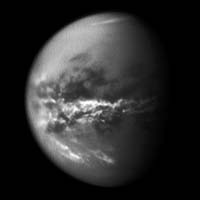|
COMETS EARTH JUPITER KUIPER BELT MARS MERCURY METEORITES NEPTUNE OORT CLOUD PLUTO SATURN SOLAR SYSTEM SPACE SUN URANUS VENUS ORDER PRINTS
PHOTO CATEGORIES SCIENCEVIEWS AMERICAN INDIAN AMPHIBIANS BIRDS BUGS FINE ART FOSSILS THE ISLANDS HISTORICAL PHOTOS MAMMALS OTHER PARKS PLANTS RELIGIOUS REPTILES SCIENCEVIEWS PRINTS
|
Related Documents
Download Options
NASA's Cassini spacecraft chronicles the change of seasons as it captures clouds concentrated near the equator of Saturn's largest moon, Titan. Methane clouds in the troposphere, the lowest part of the atmosphere, appear white here and are mostly near Titan's equator. The darkest areas are surface features that have a low albedo, meaning they do not reflect much light. Cassini observations of clouds like these provide evidence of a seasonal shift of Titan's weather systems to low latitudes following the August 2009 equinox in the Saturnian system. (During equinox, the sun lies directly over the equator. See PIA11667 to learn how the sun's illumination of the Saturnian system changed during the equinox transition to spring in the northern hemispheres and to fall in the southern hemispheres of the planet and its moons.) In 2004, during Titan's late southern summer, extensive cloud systems were common in Titan's south polar region (see PIA06110, PIA06124 and PIA06241). Since 2005, southern polar systems have been observed infrequently, and one year after the equinox, extensive near-equatorial clouds have been seen. This image was taken on Oct. 18, 2010, a little more than one Earth year after the Saturnian equinox, which happens once in roughly 15 Earth years. The cloud patterns observed from late southern summer to early southern fall on Titan suggest that Titan's global atmospheric circulation is influenced by both the atmosphere and the surface. The temperature of the surface responds more rapidly to changes in illumination than does the thick atmosphere. Outbreaks such as the clouds seen here may be the Titan equivalent of what creates the Earth's tropical rainforest climates, even though the delayed reaction to the change of seasons and the apparently sudden shift is more reminiscent of the behavior over Earth's tropical oceans than over tropical land areas. A few clouds can be seen in Titan's southern latitudes here. See PIA12813 for a movie of clouds moving through the middle southern latitudes of Titan. Some clouds are also visible in the high northern latitudes here. See PIA12811 and PIA12812 for movies showing clouds near the moon's north pole. This view looks toward the Saturn-facing side of Titan (5,150 kilometers or 3,200 miles across). North is up. The image appears slightly grainy because it was re-projected to a scale of 6 kilometers (4 miles) per pixel. Scale in the original image was 15 kilometers (9 miles) per pixel. This view consists of an average of three images taken using a filter sensitive to near-infrared light centered at 938 nanometers, which allows for detection of Titan's surface and lower atmosphere, plus an image taken using a filter sensitive to visible light centered at 619 nanometers. The images were taken with the Cassini spacecraft's narrow-angle camera at a distance of approximately 2.5 million kilometers (1.6 million miles) from Titan and at a sun-Titan-spacecraft, or phase, angle of 56 degrees. |
